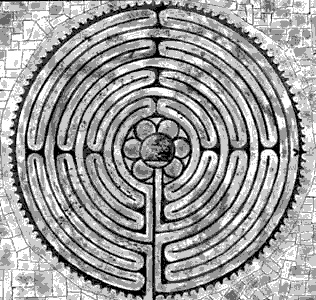Labyrinths were often used by Christian pilgrims who were unable to journey
to a holy shrine; they walked a labyrinth instead. (You might see the Camino de Santiago in Spain as a very long, stretched-out
labyrinth.) However, this structure predates Christianity and is found in many
ancient cultures. The word labyrinth is derived from
the word labrys, the sacred, double-sided axe of the Minoans, who worshipped the Mother Goddess and gave us the myth of the Minotaur.
The
cathedral at Chartres is supposed to have been built on the site of a shrine sacred to
the earth mother. Its 12-circuit labyrinth ( the centre counting as the 12th) is a rather mysterious
addition to the cathedral and is thought to connect to very ancient beliefs in
feminine deities. Look carefully, and you can see double-bladed axe-shapes.
 |
| Source: www.lessons4living.com/chartres_labyrinth.htm |
Chartres is redolent with feminine symbols in addition to the circular labyrinth. The veneration of the Virgin Mary, which arose in the early middle ages when Chartres was built (1250 A.D.), reflected a desire to balance patriarchal Roman Catholicism with the addition of the feminine. This resulted in the assimilation of the Goddess with Mary. Read more if you like at this link:
Episcopalian priest Lauren Artress notes that, if the Rose window in Chartres Cathedral, were laid on the floor of the cathedral, it would cover the labyrinth. Or at least come close. According to another authority, Robert Ferre, the centre of the Rose window misses the roseate centre of the labyrinth by five feet but is "exactly 100 of the mason's foot measures from the floor," so there does seem to be some degree of intentionality (www.labyrinthproject.com/FAQ005.html).
 |
| Source: www.discover-chartres.com/chartres-cathedral-choir-and-chapels.html |
At this
point you may want to read the Rev. Artress’s seminal book on the labyrinth, entitled Walking a
Sacred Path. She notes the many approaches to this type of process meditation: allowing the Ego to let
go, paying “gracious attention” to what is waiting to well up in you, asking a
question, repeating a mantra, reading scripture, asking for help, honouring a benchmark in
life, or working with a dream.
Working
with a dream while walking the labyrinth is engaging. I like the idea of
having something coming from the unconscious and being walked through on a path on the physical,
concrete, material (Mother) earth. Artress
adds that the pattern of the walk can be seen as one of purgation (on going
inwards), illumination (during meditation at the centre) and union (going
outwards to rejoin the world in a transformed, more compassionate, way).
I would
like to have made a 12-circuit labyrinth because it provides a more convoluted
walk in and out of the four quadrants, but it is very complicated mathematically. The little curves around the
circumference are not decoration, but are called lunations and correspond to the phases
of the moon. Getting them right would be tricky as would the pattern in
general.
I chose a simpler model — the seven-circuit labyrinth. It lacks the surprise and mystery of the 12-circuit, but for an enneagram Five, who really needs to put thought
into action, it is a good place to start. As a friend of mine used to say, "Never let the perfect become the enemy of the good."
 |
| Source: www.lessons4living.com |
No comments:
Post a Comment